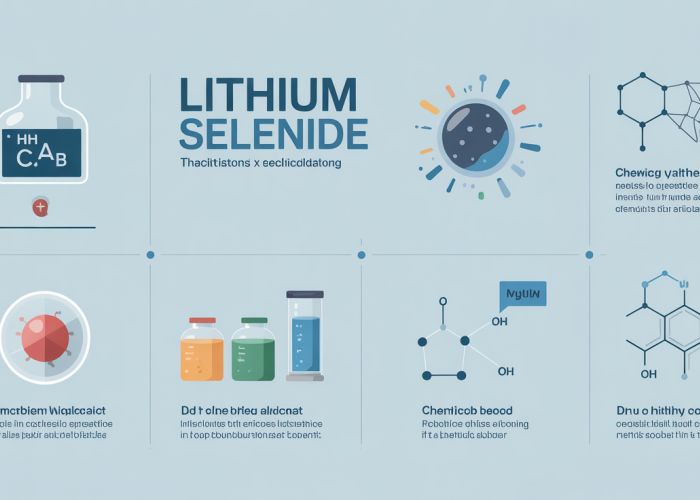Energy storage applications increasingly demand advanced materials; lithium selenide uses present a compelling avenue for exploration. Solid-state batteries, a focal point of current research, benefit from the potential of lithium selenide. Furthermore, the University of Innovation Labs actively researches novel material compositions incorporating lithium selenide. Properties of these compositions suggest the increasing importance of lithium selenide uses in the future of energy technology.

Optimizing Article Layout for "Lithium Selenide Uses: The Future is Now! #Innovation"
This guide outlines an optimal article layout to effectively cover the topic of lithium selenide uses, focusing on clarity, engagement, and information delivery.
Understanding the Core: Lithium Selenide – Properties and Basics
This section sets the foundation. Readers should understand what lithium selenide is before diving into its applications.
-
Chemical Formula and Structure: Briefly state the chemical formula (Li₂Se) and describe its crystal structure. A simple diagram or illustration would be highly beneficial here.
-
Key Properties: Highlight the relevant physical and chemical properties. This includes:
- Electrical conductivity.
- Thermal stability.
- Reactivity.
- Appearance (color, form).
-
Synthesis Methods: Summarize the common methods used to create lithium selenide. Avoid highly technical descriptions; focus on the fundamental processes.
The Expanding Landscape: Diverse Lithium Selenide Uses
This is the core section, dedicated to detailing the various applications of lithium selenide. Each application should have its own dedicated section.
Energy Storage Applications
This area is likely the most promising and should be given significant attention.
-
Solid-State Batteries:
- Explain how lithium selenide acts as a solid electrolyte.
- Discuss the advantages over traditional liquid electrolytes (e.g., safety, energy density).
- Present any current limitations or challenges (e.g., ionic conductivity).
- Compare its performance against other solid electrolyte materials. A table comparing metrics like ionic conductivity and cost could be helpful.
-
Next-Generation Battery Chemistries:
- Explore potential uses in other battery types (e.g., lithium-sulfur batteries, metal-air batteries).
- Describe how lithium selenide can improve these battery chemistries.
Semiconductor Applications
Lithium selenide’s semiconducting properties open other avenues.
-
Photovoltaic Cells:
- Describe how it can be used as a component in solar cells.
- Explain its role in light absorption and electron transport.
- Discuss any advancements or ongoing research in this area.
-
Thermoelectric Devices:
- Explain how it can be used to convert heat into electricity (or vice versa).
- Highlight its potential advantages in thermoelectric applications.
Other Emerging Applications
This section can cover less established, but potentially important uses.
-
Catalysis: Describe if and how lithium selenide acts as a catalyst for specific chemical reactions.
-
Materials Science: Mention any novel materials or composites where lithium selenide is used.
-
Medical Applications (if any): If any research exists, address potential (but thoroughly vet for accuracy and ethical considerations) applications in medicine. This section should be extremely cautious and evidence-based.
The Future Outlook: Innovation and Research Directions
This section explores the current state of research and the potential future direction of lithium selenide uses.
Current Research Trends
-
Materials Optimization: Describe research aimed at improving the properties of lithium selenide (e.g., increasing ionic conductivity).
-
Device Fabrication Techniques: Explain advancements in manufacturing processes that can facilitate the use of lithium selenide in devices.
-
Fundamental Understanding: Outline research focused on gaining a deeper understanding of the material’s properties and behavior.
Challenges and Opportunities
-
Scalability and Cost: Discuss the challenges of scaling up the production of lithium selenide at a reasonable cost.
-
Stability and Degradation: Address any issues related to the material’s long-term stability and degradation.
-
Environmental Considerations: Consider the environmental impact of lithium selenide production and use.
Potential Breakthroughs
-
Improved Battery Performance: Describe the potential for lithium selenide to contribute to the development of batteries with significantly higher energy densities and faster charging times.
-
Novel Devices: Discuss the possibility of using lithium selenide in entirely new types of electronic devices.
Supporting Information
-
Glossary of Terms: Define any specialized terminology used in the article.
-
References: Provide a comprehensive list of sources used to support the information presented. Use a consistent citation style.
-
Images and Diagrams: Incorporate relevant visuals to enhance understanding.
This layout focuses on providing a clear, informative, and engaging overview of lithium selenide uses. The combination of detailed explanations, bullet points, numbered lists, and tables will help readers quickly grasp the key concepts and potential of this innovative material.
FAQs About Lithium Selenide Uses
Here are some common questions about lithium selenide uses and its innovative potential. We hope this clarifies the future possibilities of this material.
What exactly is lithium selenide?
Lithium selenide (Li₂Se) is a chemical compound formed from lithium and selenium. It is a crystalline solid with interesting electrical and optical properties that make it a subject of ongoing research and development. Its potential applications are diverse.
What are some potential lithium selenide uses?
Current research suggests several promising lithium selenide uses. These include applications in solid-state batteries, thermoelectric devices (converting heat to electricity), and potentially in advanced semiconductors. Its specific properties are key to these potential uses.
How does lithium selenide contribute to battery innovation?
Lithium selenide’s high ionic conductivity makes it a candidate for solid-state electrolytes in next-generation batteries. This could lead to batteries with improved safety, energy density, and lifespan compared to traditional lithium-ion batteries. This is a major area of focus for lithium selenide uses.
Are there any challenges to widespread adoption of lithium selenide uses?
Yes. Current challenges include the high cost of selenium, the difficulty in manufacturing high-quality lithium selenide materials at scale, and stability issues that need to be addressed. Further research and development are necessary before widespread adoption of lithium selenide uses becomes a reality.
So, there you have it – a glimpse into the awesome world of lithium selenide uses! Hopefully, this got your brain buzzing with possibilities. Keep exploring and who knows, maybe you’ll be the one unlocking its full potential!